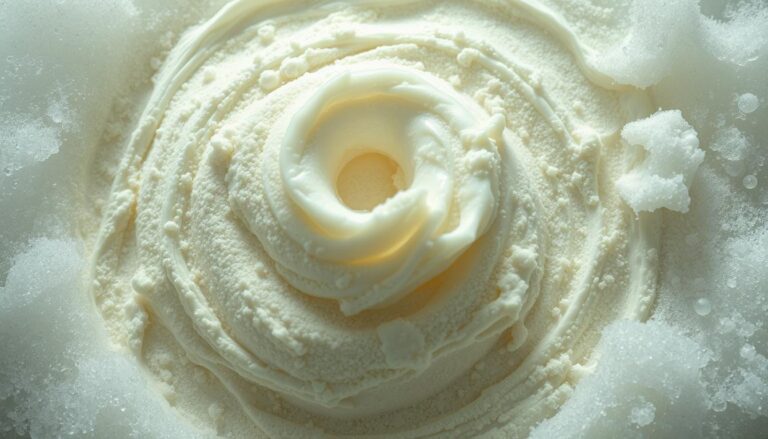Why Do I Need to Get My Teeth Polished at the End of a Cleaning?
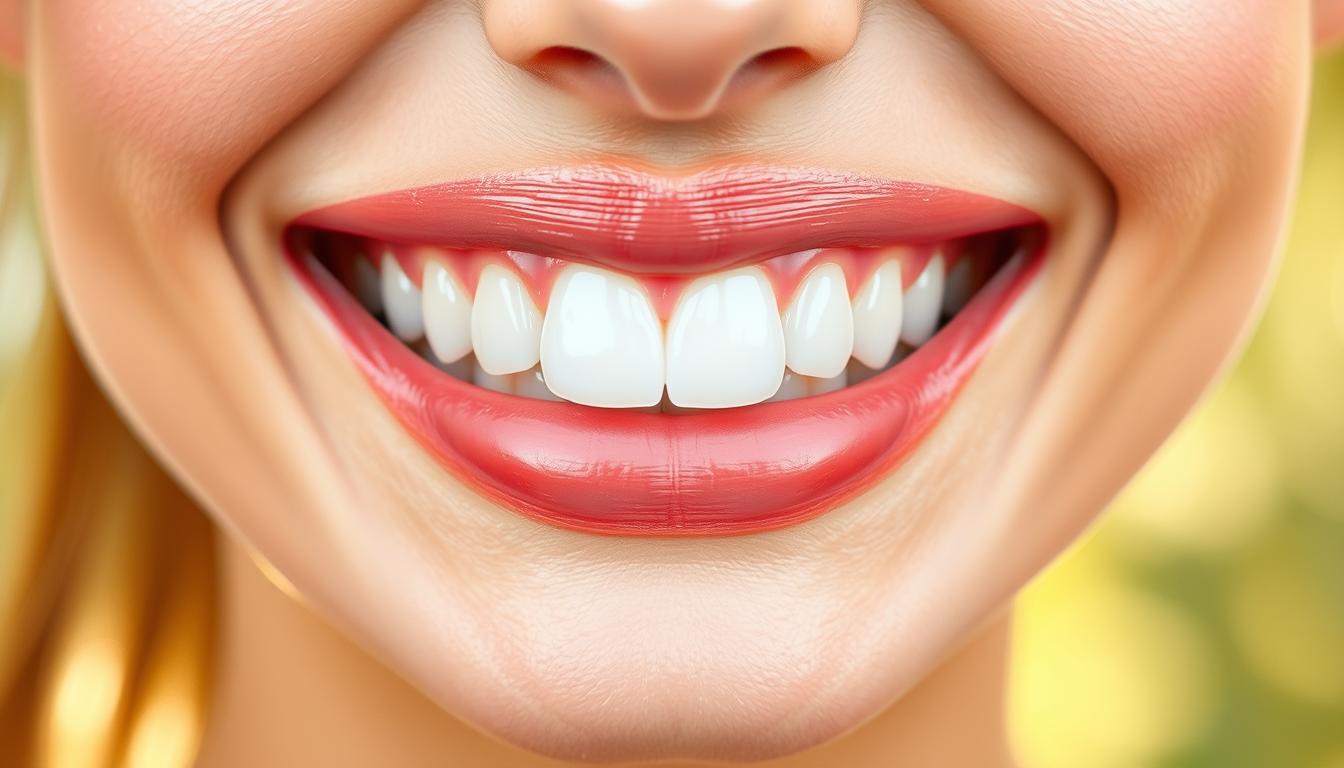
Ever thought about the final shiny step at the dentist’s office? It’s not just for looks. Dental teams polish teeth to get rid of tough stains and bacteria that regular cleaning might miss.
This step removes leftover residue and makes teeth look better. It might wear off a thin layer if done too much. But, dentists use gentle methods to keep your enamel safe. Getting a full cleaning before polishing helps keep your mouth healthy and your smile bright.
Key Takeaways
- Polishing helps eliminate extrinsic stains and plaque remnants.
- It compliments scaling and routine dental cleaning for optimal oral hygiene.
- Trained experts use gentle polishing compounds to protect enamel.
- Over-polishing can cause minor surface wear if not done carefully.
- Regular professional cleanings safeguard gum health and prevent decay.
- Scheduling medical checkups ensures long-term oral health benefits.
Importance of Dental Cleanings
Proper care of teeth and gums is key to good oral health. Routine dental cleanings remove plaque that brushing can miss. Scaling and polishing help reduce bacteria and keep your breath fresh.
Maintaining Oral Health
Regular dental visits improve your oral hygiene. They reach areas a toothbrush can’t. Tartar, harder than plaque, sticks to enamel.
Scaling makes the surface smoother. This makes brushing easier and more effective.
Preventing Gum Disease
Gum inflammation starts with hidden bacteria near the gum line. Professional cleanings cut down on these pathogens. This lowers the risk of periodontitis.
Early treatment prevents bigger problems later on.
Eliminating Tartar Build-Up
Tartar irritates soft tissue and can cause cavities. Experts use special tools to remove mineralized layers. This leaves teeth free from stubborn debris.
This approach helps keep your teeth stable for a long time.
Understanding Teeth Polishing
Many patients love the satin-like finish after treatment. This technique makes teeth shine, boosting confidence. It uses mild abrasives and tools like rubber cups or special devices.
What is Teeth Polishing?
Teeth polishing is a final step in dental care. It makes teeth look smoother and brighter. Dentists use a slow-speed drill and a soft cup for this.
Some use baking soda powder for a better polish. This method leaves teeth looking sleek and can lessen light stains.
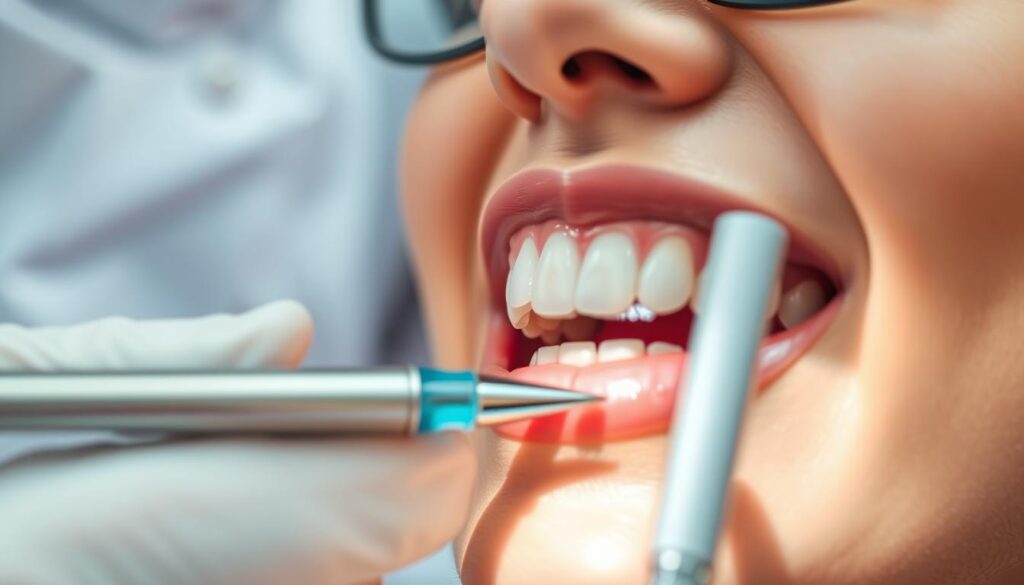
How is it Different from Cleaning?
Cleaning focuses on removing plaque and tartar for gum health. Polishing, on the other hand, aims to remove minor stains and improve tooth shine. For more on preventive care, check out this useful guide.
| Aspect | Polishing | Cleaning |
|---|---|---|
| Primary Goal | Boost shine and remove light stains | Eliminate plaque and prevent disease |
| Method | Rubber cup or powder spraying | Scaling tools and flossing |
| Outcome | Glossy finish | Cleaner, healthier gum line |
Benefits of Teeth Polishing
Polishing your teeth does more than just clean them. It gives your smile a shiny finish and makes your teeth stronger against future stains. This process removes tiny particles that brushing can’t catch, leaving your teeth looking bright and healthy.
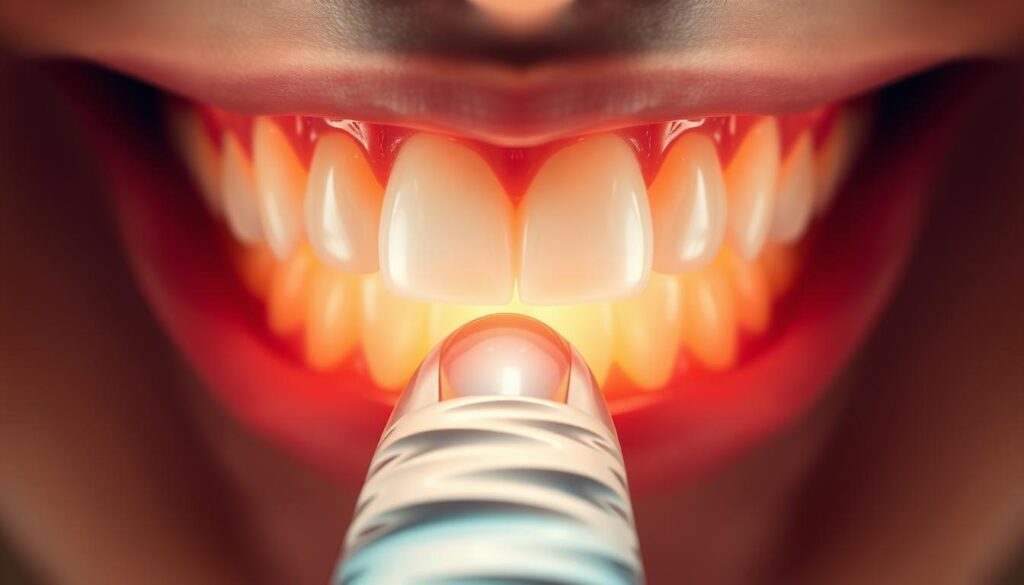
Enhancing Aesthetics
Polished teeth reflect light better, making your smile look cleaner and brighter. Many people get their teeth polished to achieve a flawless look. It leaves your teeth feeling smooth and looking even.
Reducing Stains and Discoloration
Polishing can make small stains and discolorations disappear. It removes the top layer of plaque and residue, revealing a brighter tooth. This process also reaches areas that brushing can’t, making your teeth look more even.
Smoothing the Tooth Surface
A smooth tooth surface is harder for bacteria to stick to. This makes it easier to keep your teeth clean and can improve your oral health. Plus, it feels better when you brush your teeth.
The Polishing Process
Dental teams focus on a finishing step that refines each cleaning. They make sure every tooth has a smooth surface. This stage clears out any leftover debris and gives the mouth a polished feel.
It makes the transition from scaling to a final sparkle smooth. This reinforces patient comfort.
Steps Involved
Clinicians follow a systematic approach for optimal outcomes:
- Rinse and irrigation to eliminate leftover particles
- Placement of a specially formulated paste
- Gentle rotation with a prophy cup or brush to remove lingering deposits
- Final inspection to confirm consistent shine and cleanliness
Tools Used in Polishing
Many professionals choose hand-held attachments or engine-driven polishers. They use soft rubber cups or brush tips. Some use air-powder devices with baking soda powder, a low-abrasion option for minor stains.
These tools preserve tooth enamel by minimizing friction. They achieve a confident polish.
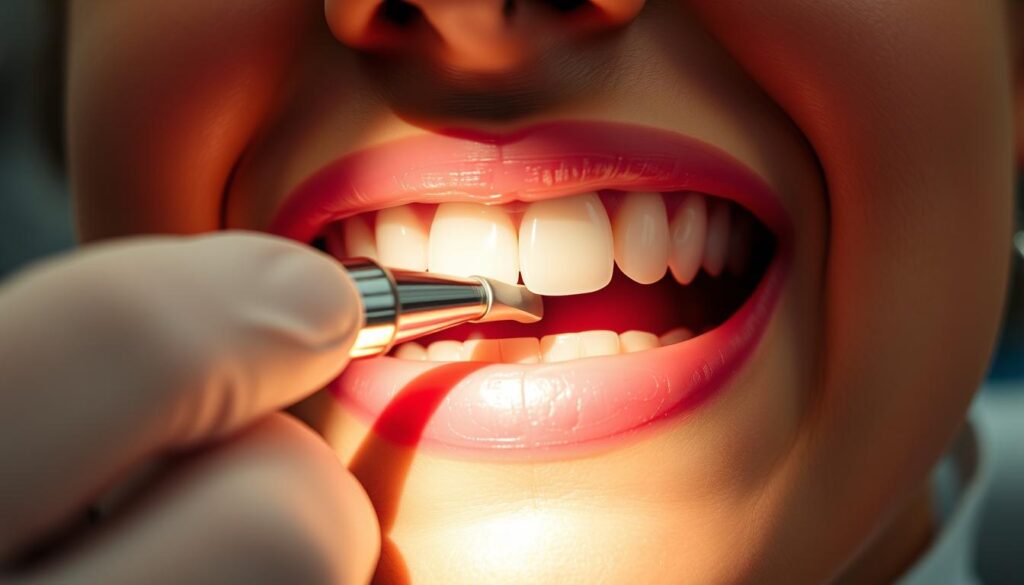
Frequency of Teeth Polishing
How often you should get your teeth polished depends on your oral health and goals. Some people prefer selective polishing for areas prone to stains and plaque. It’s best to talk to your dentist to find the right approach for you.
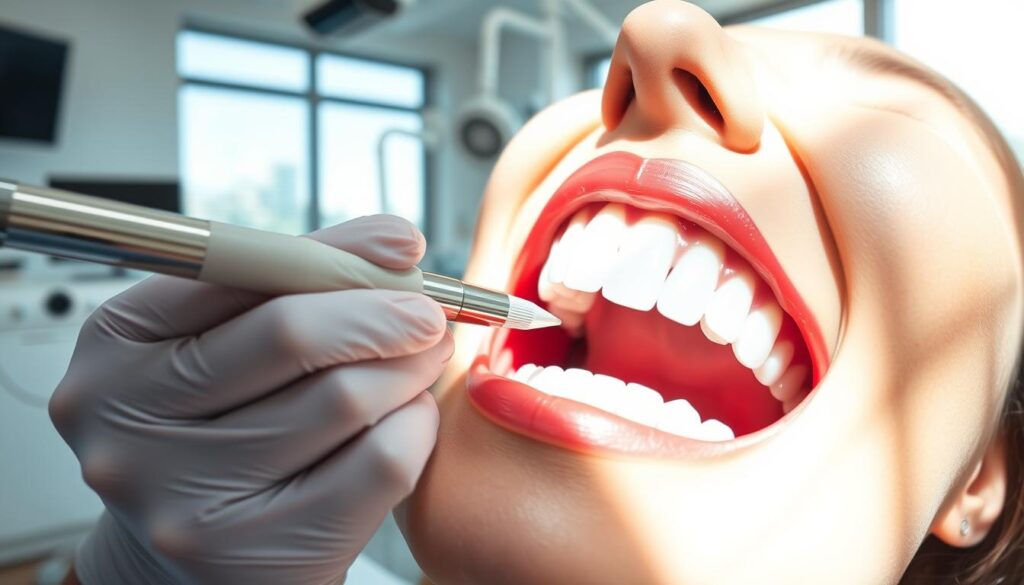
How Often Should You Get Polished?
Some people polish their teeth at every dental cleaning and exam. Others might polish less often if their teeth don’t stain as much. An annual checkup can help figure out the best schedule for you. Dentists aim to protect your enamel while keeping your smile bright.
Factors That Influence Frequency
Several things can affect how often you need teeth polishing:
- Lifestyle habits: Drinking coffee, tea, or smoking can make polishing more necessary.
- Enamel sensitivity: Some people do better with selective polishing.
- Previous restorations: Crowns or veneers need extra care.
Each of these factors plays a role in how often you should polish your teeth. Dentists customize care for you, aiming for the best oral health with minimal procedures.
Common Myths About Teeth Polishing
Many think dental polishing is just for looks. But it’s more than that. It helps keep your mouth healthy and boosts your confidence. Dentists in the U.S. say it’s great for a clean, shiny smile and better oral health.
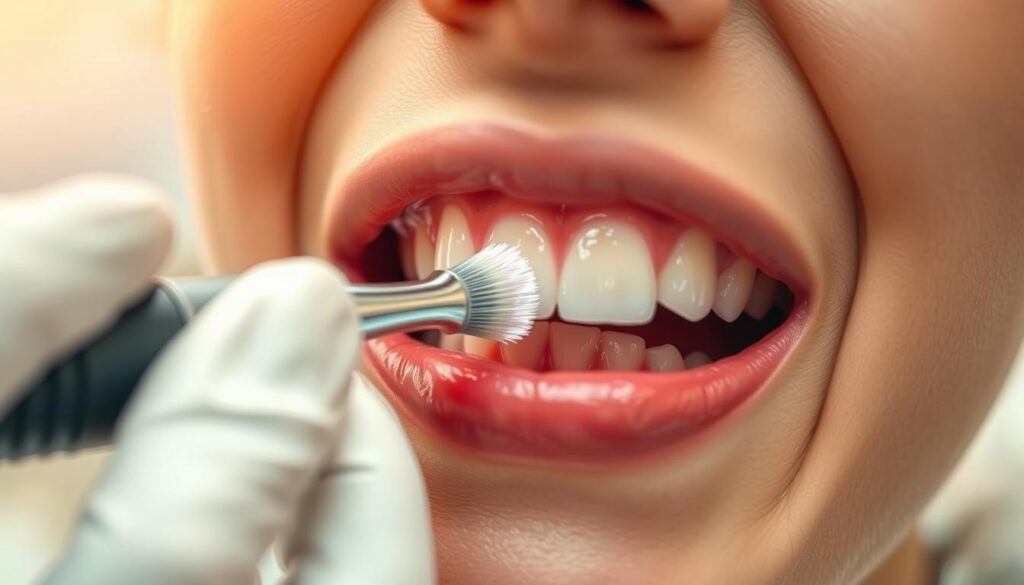
Misconception: It’s Just for Looks
Polishing makes your teeth smoother and stops plaque from building up. This helps your gums stay healthy and prevents deep stains. It also makes your enamel stronger, making it harder for bacteria to stick around.
Misconception: It Damages Enamel
Some worry that polishing can weaken enamel. But dental offices use special, safe products. These are approved by the American Dental Association. They protect your teeth while polishing them.
Dentists follow strict rules and use gentle methods. This keeps your enamel safe and healthy.
The Role of Dental Professionals
Dentists and hygienists work together to keep smiles healthy. They use special techniques to ensure your mouth stays in top shape. They adjust their methods for each patient, making sure everyone gets the best care.
They often use selective polishing to remove tough stains. This way, they protect your teeth while getting rid of the bad stuff. Their work is based on the latest research and a commitment to your health.
Who Performs Teeth Polishing?
Dental hygienists are trained to do teeth polishing. They use special tools to clean your teeth well. Dentists check on tricky cases and suggest extra treatments when needed.
Why Experience Matters
Experienced professionals know how to clean hard-to-reach areas safely. They make sure you’re comfortable and get the best results. Their skill ensures your teeth are polished without harm.
Cost of Teeth Polishing
When it comes to dental care, cost is a big factor. Prices can change based on where you are, the clinic’s reputation, and if you have insurance. Some insurance plans cover polishing as part of regular care. But, deeper cleanings like scaling and root planing might cost extra. To understand more, check out the dental cleaning procedure and how polishing fits into it.
Average Costs in the United States
Prices can differ depending on where you are. In cities, a polishing appointment can start at $80 and go up to $150 or more. Some places offer polishing as part of a cleaning package. But, you might have to pay extra for extra treatments.
Is It Worth the Investment?
Good oral health can prevent future problems, and polishing is a key part of that. It helps keep your teeth smooth and free of stains. A clean smile can boost your confidence and help prevent plaque buildup. For many, the benefits of a professional polish are well worth the cost.
| Region | Approximate Range | Notes |
|---|---|---|
| East Coast | $80 – $120 | Often included with routine visits |
| Midwest | $70 – $110 | Insurance coverage varies |
| West Coast | $90 – $150 | Higher-end clinics may charge more |
Alternatives to Professional Polishing
Many people try to keep their smiles bright at home. They use store-bought dental kits or household items to remove stains.
At-Home Polishing Solutions
People often use gentle scrub products or baking soda pastes. These can help remove stains on teeth. But, it’s important to use non-abrasive tools to avoid damaging enamel or gums.
Using a soft-bristled brush with gentle pressure is best. This way, you can clean your teeth without harming them.
- Dental polisher kits with mild abrasive paste
- Rubber-backed strips for surface polishing
- Low-intensity whitening gels
Effectiveness Compared to Professional Care
Home methods can handle small stains but miss deeper issues. Professional polishing uses special tools to remove tough tartar and polish enamel well. Experts also reach hard-to-get areas, which helps prevent oral health problems.
While home care is convenient, dental visits are more thorough. They ensure your teeth and mouth are in the best shape.
Risks and Considerations
Every polishing procedure has its own set of risks. Dental professionals carefully consider these before deciding if it’s right for you. This helps ensure your comfort and long-term health.
Who Should Avoid This Procedure?
Some people should talk to a dentist about other options:
- Those with acute gingival inflammation
- People with newly erupted teeth that are sensitive
- Individuals with respiratory problems
| Condition | Suggested Action |
|---|---|
| Severe tooth wear | Use softened paste or polish with less pressure |
| Chronic sensitivity | Try milder treatments or special products |
Potential Side Effects
Some people might feel dryness or mild discomfort after teeth polishing. Dentists use gentle methods to reduce these effects. Talking about your medical history can help avoid problems and get better results.
Post-Polishing Care
Keeping your teeth shiny after a professional polish is key. It helps protect your enamel and stops plaque from forming too soon.
Staying on top of your oral health is important. Brushing your teeth daily with a soft brush gets rid of food bits near your gums. Flossing keeps your teeth clean in tight spots and prevents cavities. Eating a balanced diet that’s low in sugar helps keep your teeth looking bright.
Best Practices After Polishing
- Thorough brushing each morning and evening
- Flossing to eliminate hidden food particles
- Regular checkups with a licensed dentist
How to Maintain Results
Keeping your teeth looking good long-term means being careful. Why let new stains ruin your smile when you can avoid them? Drinking water, rinsing after meals, and getting regular cleanings help keep your teeth looking great.
| Care Step | Benefit |
|---|---|
| Mouthwash Use | Reduces bacteria and freshens breath |
| Dietary Moderation | Limits sugary acids that can erode enamel |
| Frequent Evaluations | Identifies early signs of tartar or gum concerns |
Conclusion
Teeth polishing is a key part of keeping your mouth healthy. It makes your teeth smooth and helps them stay that way. This makes your teeth feel better and look brighter.
Recap of Benefits
Teeth polishing offers many advantages:
- Smoother Teeth: It makes your teeth feel smoother and prevents plaque buildup.
- Aesthetic Appeal: It makes your smile look fresher by removing small stains.
- Improved Hygiene: It makes brushing easier by cleaning your teeth better.
Encouragement to Schedule Regular Appointments
Going to the dentist regularly is important. It helps catch problems early and keeps your teeth clean. This saves you time and money in the long run.
Regular visits help keep your gums healthy and your teeth shining. It’s a way to work together with your dentist to keep your mouth healthy.
FAQs
This final part answers common questions about teeth polishing. It’s a quick step after a dental cleaning to keep your mouth healthy.
How Long Does the Polishing Take?
Polishing usually takes just a few minutes. A dentist uses a soft brush or rubber cup. This removes small stains and makes your teeth smooth.
Can I Skip Polishing?
Skipping polishing might make your teeth look less shiny. Dentists and the American Dental Association say polishing is important. It helps keep your teeth clean and gums healthy.


